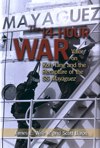 James E. Wise and Scott Baron’s examination of “the last battle of the Vietnam War” is a gripping and taut account of an intelligence blunder, micromanagement by the National Command Authority, and American hubris emerging from a grim, 10-year conflict with a disastrous outcome. When Cambodian Khmer Rouge forces seized the Mayaguez on May 14, 1975, the former U.S.-allied nations of Indochina were reeling in defeat. Saigon had fallen on April 30. The Khmer Rouge, whose atrocities in the bizarre, inhumane social experiment, Angkha, were still unknown, had ousted the Lon Nol government in Phnom Penh three weeks earlier. The Pathet Lao were rapidly rolling up the Royal Lao government and would gain complete control of Laos by December.
James E. Wise and Scott Baron’s examination of “the last battle of the Vietnam War” is a gripping and taut account of an intelligence blunder, micromanagement by the National Command Authority, and American hubris emerging from a grim, 10-year conflict with a disastrous outcome. When Cambodian Khmer Rouge forces seized the Mayaguez on May 14, 1975, the former U.S.-allied nations of Indochina were reeling in defeat. Saigon had fallen on April 30. The Khmer Rouge, whose atrocities in the bizarre, inhumane social experiment, Angkha, were still unknown, had ousted the Lon Nol government in Phnom Penh three weeks earlier. The Pathet Lao were rapidly rolling up the Royal Lao government and would gain complete control of Laos by December.
Back in Washington, Gerald R. Ford was an unelected and untried president, and determined to put the Vietnam War experience behind him while preserving the nation’s preeminence as a superpower.
While the chaos of two major evacuations, Eagle Pull in Phnom Penh on April 12, and Frequent Wind in Vietnam two weeks later, did leave a residual force of navy ships in the region and U.S. Air Force aircraft in Thailand, the elements of disaster were forming in the complicated structure of the operation, as the authors outline: “Additionally, the command and control element of this joint service operation was at best cumbersome. The president and the National Security Council; the Joint Chiefs of Staff; the National Military Command Center in Washington, D.C.; Air Force Lt. Gen. John J. Burns, theater commander headquartered at Nakhon Phanom, Thailand; and Adm. Noel Gayler, CINCPAC, all monitored events and could give input in real time. Unfortunately, inquiries for information from a myriad of sources often tied up communication channels at critical times, obstructing tactical operations.”
The disasters began with the crash of a helicopter, killing an entire contingent of Air Force security personnel in Thailand on May 13. How the dramatic hours that followed unfolded has been told in other books: the faulty intelligence, the decision to cease combat operations while the landing force was still engaged and the cumbersome, unwieldy command and control structure. In The 14-Hour War, this fact-laden chronology serves as the backlight for the accounting of the battle by 23 participants, the book’s final chapter that actually makes up more than half of its 300 pages. This oral history approach adds immeasurably to the readers’ understanding of the battle, giving this odd and uncomfortable chapter of our war in Southeast Asia greater texture and dimension. The participants who tell their stories include the commander of Marine Battalion Landing Team, 2nd Battalion, 9th Marines; sailors from the destroyer Wilson, which provided support during the extraction, and Air Force helicopter and fixed wing crews that provided air cover for the entire 14-hour period. Wise, a former naval pilot, and Baron, a veteran of the U.S. Army, let the participants tell their stories factually and without emotion, and the mosaic of multiple insertions and extractions and close combat on the ground unfold.
The authors also detail the Joint Personnel Accounting Command’s (JPAC) exhaustive searches of the island and mainland two decades after the battle for a Marine three-man machine gun team inadvertently left behind during the tumultuous withdrawal.
In 1995 I visited Koh Tang as part of the Joint Task Force-Full Accounting/Central Identification Laboratory Hawaii search and recovery force. The island was still a desolate and dangerous place as unexploded ordnance was gingerly being retrieved from the beach and jungle for destruction. We swam out to the wrecked CH-53 a few hundred yards offshore, its exposed masthead a stark monument to the final chapter in America’s Indochina adventure. This was the first attempt to resolve the Marines’ fates, and JPAC’s continued efforts underscore the commitment to recover and identify as many as possible from the war.
Leadership during the battle and the tenacity of the fighting men curtailed a final military disaster at Koh Tang. The authors have masterfully captured it in this work.
Naval Institute Press, 2011




